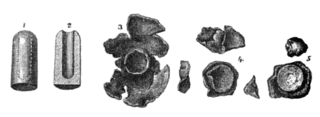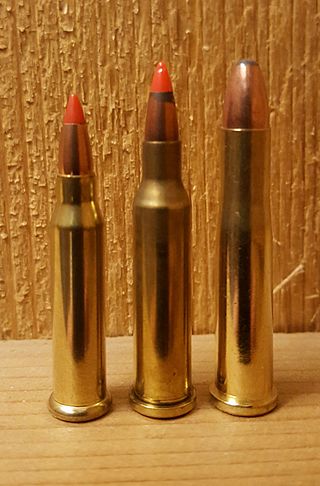
A cartridge, also known as a round, is a type of pre-assembled firearm ammunition packaging a projectile, a propellant substance and an ignition device (primer) within a metallic, paper, or plastic case that is precisely made to fit within the barrel chamber of a breechloading gun, for convenient transportation and handling during shooting. Although in popular usage the term "bullet" is often used to refer to a complete cartridge, the correct usage only refers to the projectile.

The Martini–Henry is a breech-loading single-shot rifle with a lever action that was used by the British Army. It first entered service in 1871, eventually replacing the Snider–Enfield, a muzzle-loader converted to the cartridge system. Martini–Henry variants were used throughout the British Empire for 47 years. It combined the dropping-block action first developed by Henry O. Peabody and improved by the Swiss designer Friedrich von Martini, combined with the polygonal rifling designed by Scotsman Alexander Henry.

An elephant gun is a large caliber gun, rifled or smoothbore, originally developed for use by big-game hunters for elephant and other large game. Elephant guns were black powder muzzle-loaders at first, then black powder express rifles, then later used smokeless powder cartridges.

In firearms, headspace is the distance measured from a closed chamber's breech face to the chamber feature that limits the insertion depth of a cartridge placed in it. Used as a verb by firearms designers, headspacing refers to the act of stopping deeper cartridge insertion. The exact part of the cartridge that seats against the limiting chamber feature differs among cartridge and gun designs. In general, bottleneck rifle cartridges headspace on their case shoulders; rimmed cartridges headspace on the forward surfaces of their case rims; and rimless pistol cartridges headspace on their case mouths. The case belts on belted cartridges were originally added to allow headspacing on the belt's forward surface, But in practice, this is often vestigial, and rifles chambered for belted cartridges may well headspace them on their shoulders and still be within CIP or SAAMI dimensional limits. However, belted cartridges and their corresponding chambers at their nominal CIP or SAAMI dimensions will headspace on the belt.

The .460 Weatherby Magnum is a belted, bottlenecked rifle cartridge, developed by Roy Weatherby in 1957. The cartridge is based on the .378 Weatherby Magnum necked up to accept the .458-inch (11.6 mm) bullet. The original .378 Weatherby Magnum parent case was inspired by the .416 Rigby. The .460 Weatherby Magnum was designed as an African dangerous game rifle cartridge for the hunting of heavy, thick skinned dangerous game.

The term express was first applied to hunting rifles and ammunition beginning in the mid-19th century, to indicate a rifle or ammunition capable of higher than typical velocities. The early express cartridges used a heavy charge of black powder to propel a lightweight, often hollow point bullet, at high velocities to maximize point blank range. Later the express cartridges were loaded with nitrocellulose-based gunpowder, leading to the Nitro Express cartridges, the first of which was the .450 Nitro Express.
A rim is an external flange that is machined, cast, molded, stamped, or pressed around the bottom of a firearms cartridge. Thus, rimmed cartridges are sometimes called "flanged" cartridges. Almost all cartridges feature an extractor or headspacing rim, in spite of the fact that some cartridges are known as "rimless cartridges". The rim may serve a number of purposes, including providing a lip for the extractor to engage, and sometimes serving to headspace the cartridge.

The double rifle, also known as a double-barreled rifle, is a rifle with two barrels mounted parallel to each other that can be fired simultaneously or sequentially in quick succession. Synonymous with big game hunting found primarily in Africa and Asia, the double rifle is a sporting weapon with very little military heritage.

The .700 Nitro Express (17.8×89mmR) is a big game rifle cartridge. The cartridge is typically charged with around 250 grains of powder, in addition to a two-grain igniter charge. The cartridge was introduced in 1988 by the boutique gunmakers Holland & Holland (H&H) of London. It was developed by Jim Bell and William Feldstein and built by H&H. Feldstein had tried unsuccessfully to get H&H to build a .600 Nitro Express for him, but they had already ceased production. However, when Bell and Feldstein produced an entirely new .700 Nitro Express cartridge, they were able to attract the interest of H&H, which was looking for a new big-bore cartridge. After production began, the backlog of orders was so great that it continued to 2007 and H&H restarted the production of .600 Nitro Express guns.

The Nitro Express (NE) series of cartridges are used in large-bore hunting rifles, also known as elephant guns or express rifles, but later came to include smaller bore high velocity British cartridges.
The .600 Nitro Express is a large bore Nitro Express rifle cartridge developed by W.J. Jeffery & Co for the purpose of hunting large game such as elephant.
The .577 Nitro Express is a large-bore centerfire rifle cartridge designed for the purpose of hunting large game such as elephant. This cartridge is used almost exclusively in single-shot and double express rifles for hunting in the Tropics or hot climates in general and is a cartridge associated with the golden age of African safaris and Indian shikars.

The .17 Hornet is a .17 caliber centerfire rifle cartridge originally offered as a "wildcat cartridge" developed by P.O. Ackley in the early 1950s. He created this non-factory (wildcat) offering by simply necking-down the .22 Hornet to .17 caliber and fire-forming the resized cases in his new chamber design. The result was a small quiet cartridge capable of high velocity. Ackley mentions it as one of the most balanced of the .17 cartridges of his time; likely, this is still true.

The .458 Lott is a .458 caliber rifle cartridge designed for the purpose of hunting large, thick-skinned dangerous game animals in Africa. It is based on the full length .375 H&H Magnum case blown out and shortened to 2.800 inches (71.1 mm).
The .500 Jeffery (13x70mmRB) is a big-game rifle cartridge that first appeared around 1920, and was originally introduced by the August Schuler Company, a German firm, under the European designation "12.7×70mm Schuler" or ".500 Schuler". When offered by the famed British outfitter W.J. Jeffery & Co, it was renamed the .500 Jeffery so as to be more palatable to British hunters and sportsmen following World War One.
The .400 Purdey, also known as the .400 3-inch Straight and .400 Purdey Light Express 3-inch, is an obsolete rifle cartridge developed by James Purdey & Sons.
The .360 No 2 Nitro Express is a centerfire rifle cartridge developed by Eley Brothers and introduced in 1905.
The .600/577 Rewa, also known as the .600/577 Rewa Nitro Express, Holland's .600/577 and the .577 Rewa, is an obsolete big bore rifle cartridge.
The 20/577 Alexander Henry, also known as 20/577 Express, is an obsolete rifle cartridge.











